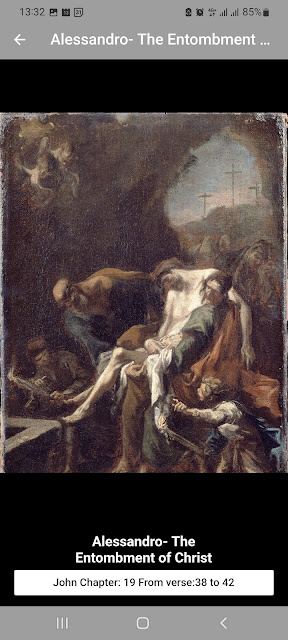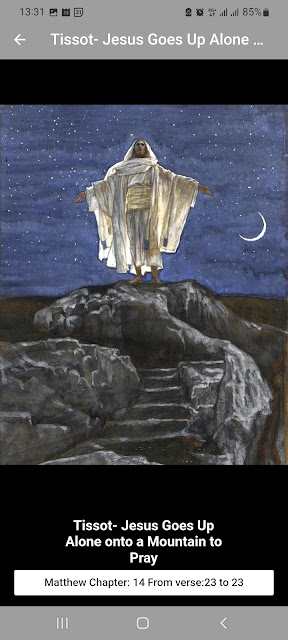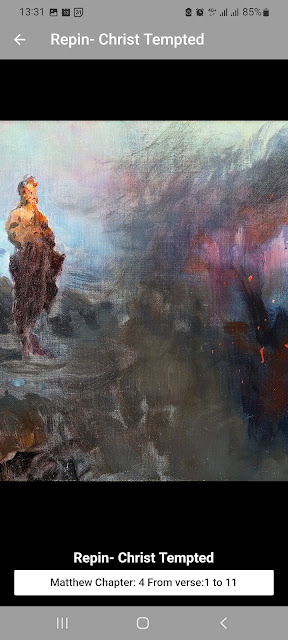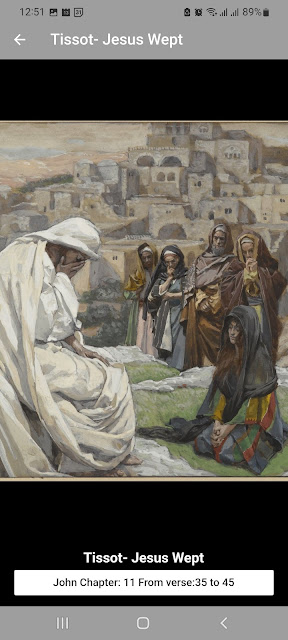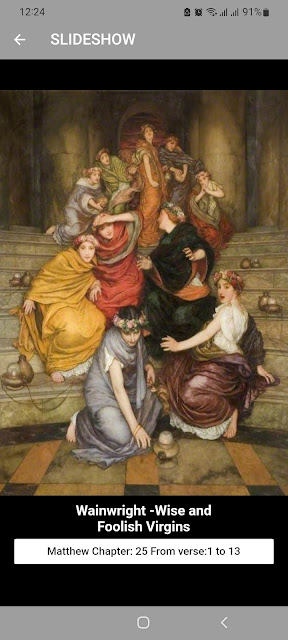1. Carl Heinrich Bloch Christ tempted
View more Images here
Bloch's painting portrays a contemplative Jesus standing on a rocky precipice, with Satan appearing before him in a sinister and tempting manner. The artist's attention to detail and his skillful use of light and shadow create a dramatic and emotional atmosphere.
Carl Bloch's painting of Jesus tempted is considered one of his most famous and influential works. It has been widely reproduced and is often admired for its technical mastery and its ability to capture the spiritual and moral struggle of Jesus during his time of testing.
2. Allesandro The entombment of Christ
View more Images here
The painting is a powerful reminder of the human cost of Christ's death, but it also offers a message of hope. The light shining through the clouds suggests that even in the darkest of times, there is always hope for a better future.
The painting is also a testament to Magnasco's skill as a painter. He was able to capture the emotional intensity of the scene with a few deft brushstrokes. The painting is a powerful and moving work of art that is sure to leave a lasting impression on the viewer.
3. Tissot Jesus goes up alone onto a mountain to pray
View more Images here
The painting is set at night, with a crescent moon and stars in the sky. Jesus is dressed in a white robe and stands with his arms outstretched, looking up at the sky. He is surrounded by darkness, but his figure is illuminated by a soft light. The painting is full of symbolism, with the mountain representing Jesus's journey to God, the stars representing his divinity, and the darkness representing the world he has come to save.
Tissot's painting is a beautiful and moving depiction of Jesus's prayer life. It is a reminder that Jesus was always in communion with God, even when he was surrounded by darkness. The painting is also a powerful reminder of Jesus's mission to save the world.
The painting is currently on display at the Brooklyn Museum in New York City.
4. Repin - Christ Tempted
View more Images here
The painting shows Jesus standing on a rock, looking down at the devil, who is kneeling before him. The devil is holding a loaf of bread and a stone, and he is urging Jesus to turn stones into bread and to throw himself down from the rock, so that the angels will come and save him. Jesus is resisting the devil's temptations, and he is pointing to the sky, as if to say that his power comes from God.
The painting is full of symbolism. The rock represents Jesus's strength and determination, while the devil represents temptation and sin. The bread and the stone represent the material world and the spiritual world, respectively. The angels represent God's protection and guidance.
Repin's painting is a powerful and moving depiction of the temptation of Christ. It is a reminder that even the Son of God was tempted by the devil, but he resisted those temptations and remained true to his mission. The painting is also a reminder that we are all faced with temptations, but we can overcome them if we have faith in God.
The painting is currently on display at the Tretyakov Gallery in Moscow.
5. Heinrich Hoffman Christ and the rich young ruler
View more Images here
6. Kramskoy Christ prays in the desert
View more images here
The painting depicts Jesus after his baptism, when he was led by the Spirit into the desert to be tempted by the devil. Jesus is sitting on a rock, his head bowed in thought. He is surrounded by rocks and boulders, and the landscape is barren and desolate. The painting is full of symbolism. The rocks and boulders represent the challenges and obstacles that Jesus will face in his ministry. The barren landscape represents the spiritual wilderness that Jesus must enter in order to fulfill his mission. The red tunic underneath Jesus's dark wrap represents his divinity.
Kramskoi's painting is a powerful and moving depiction of Jesus's temptation in the desert. It is a reminder of the challenges that Jesus faced, and the strength and determination that he needed to overcome them. The painting is also a reminder of the importance of prayer and meditation in our own lives.
7. Tissot Jesus wept
View more images here
The painting is set in a dark and gloomy landscape. Jesus is seated in front of the tomb, his head bowed in grief. He is surrounded by his disciples, who are also weeping. The painting is full of symbolism. The tomb represents death, while the darkness represents the despair that Jesus and his disciples feel at the loss of Lazarus. The weeping disciples represent the human condition, and the fact that we all experience grief and loss.
Tissot's painting is a powerful and moving depiction of Jesus's grief at the death of his friend. It is a reminder that even Jesus, the Son of God, experienced human emotions such as grief and loss. The painting is also a reminder that we are not alone in our grief, and that there is hope even in the darkest of times.
The painting is currently on display at the Brooklyn Museum in New York City.
8. Ivanov Christ cleanses the temple
View more Images here
The painting is full of symbolism. The Temple represents the religious establishment, while the money changers and vendors represent the corruption and greed that Jesus was trying to fight against. The animals represent the innocent victims of this corruption.
The painting is a powerful and moving depiction of Jesus's anger at the corruption of the religious establishment. It is also a reminder of Jesus's mission to bring about a new and better world, a world free from corruption and greed.
The painting was not well-received by the Russian Orthodox Church, which saw it as a criticism of the Church. The painting was eventually purchased by the Russian Tsar, Alexander II, who placed it in the Winter Palace in St. Petersburg. The painting is currently on display at the State Russian Museum in St. Petersburg.
9. Carravagio The incredulity of St Thomas
View more Images here
The painting depicts the scene from the Gospel of John in which Thomas, one of the Twelve Apostles, refuses to believe that Jesus has risen from the dead until he can see and touch his wounds. In the painting, Thomas is kneeling before Jesus, who is pointing to his wounds. Thomas's face is filled with doubt and disbelief.
The painting is a powerful and moving depiction of Thomas's doubt and Jesus's love. It is also a reminder of the importance of faith, even in the face of doubt.
Caravaggio was a master of chiaroscuro, a technique that uses strong contrasts between light and dark to create a sense of drama and tension. In The Incredulity of Saint Thomas, Caravaggio uses chiaroscuro to great effect. The figures of Jesus and Thomas are bathed in light, while the background is dark and shadowy. This creates a sense of isolation and intimacy, as if the viewer is witnessing this moment in private.
The painting is also notable for its realism. Caravaggio was known for painting his subjects in a realistic style, and The Incredulity of Saint Thomas is no exception. The figures of Jesus and Thomas are depicted in great detail, and their expressions are full of emotion. This realism helps to make the painting more believable and moving.
The Incredulity of Saint Thomas is one of Caravaggio's most famous paintings. It is a powerful and moving depiction of faith, doubt, and love.
10. Van Gogh Parable of the sower
View more Images here
In his later versions of The Sower, van Gogh used bolder colors and more expressive brushstrokes. He also experimented with different perspectives, creating a sense of movement and dynamism. The Sower is one of van Gogh's most iconic paintings, and it continues to be a source of inspiration for artists and viewers alike.
Here are some of the interpretations of The Sower:
The sower represents the artist, who is sowing seeds of knowledge and understanding.
The seeds represent the ideas and values that the artist is trying to communicate.
The different types of soil represent the different ways that people receive these ideas and values.
The sun represents the hope and promise of a better future.
The Sower is a powerful and hopeful painting that reminds us of the importance of art and creativity. It is a reminder that we all have the power to sow seeds of change in the world.
11. Watts Good Samaritan
View more Images here
Watts was a prolific artist, and he produced a wide range of works, including portraits, allegorical paintings, and sculptures. He was particularly interested in the human condition, and he often used his art to explore themes such as love, loss, and mortality. Watts's work was often controversial, but he was also highly respected by his contemporaries. He was elected a Royal Academician in 1861, and he was knighted in 1895.
12. Wainwright - Wise and foolish virgins
View more Images here
Wainwright's painting is full of symbolism. The five wise virgins are dressed in white, while the five foolish virgins are dressed in black. The wise virgins are calm and serene, while the foolish virgins are agitated and anxious. The wise virgins have their lamps full of oil, while the foolish virgins have their lamps empty. The bridegroom is a powerful and majestic figure, and the wedding feast is a symbol of heaven.
Wainwright's painting is a powerful reminder of the importance of being prepared for the second coming of Christ. The wise virgins are those who have accepted Jesus Christ as their Savior and have been baptized. They are those who have been filled with the Holy Spirit and who are living a life of obedience to God. The foolish virgins are those who have not accepted Jesus Christ as their Savior. They are those who are living a life of sin and disobedience to God.
Wainwright's painting is a call to all Christians to be prepared for the second coming of Christ. We should be like the wise virgins, who were prepared for the bridegroom's arrival. We should have our lamps full of oil, which represents our faith in Jesus Christ. We should be living a life of obedience to God, and we should be ready to meet the Lord when he comes.
We continue in the next post
Enjoy!

